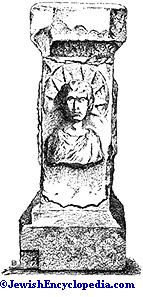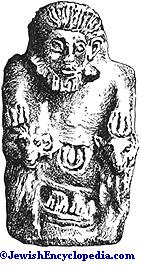BA'AL AND BA'AL-WORSHIP.

The wide-spread and primitive Semitic root ("ba'al") may be most nearly rendered in English by "possess." The term "Ba'al," therefore, which is usually explained as meaning "lord," is properly "possessor" or "owner," and is so used in a great variety of applications in common Hebrew speech. Thus we read of the "ba'al" of a house, of land, of goods, of a woman (that is, as a husband). It is also generalized so far as to be a mere noun of relation. Thus a "ba'al of dreams"is a dreamer; a "ba'al of anger" is an angry man; a "ba'al of wings" is a bird; a "ba'al of edges" is two-edged; "ba'alim of a covenant" are allies; "ba'als of an oath" are conspirators. Further, a "ba'al" may be the owner of animals (Isa. i. 3; Ex. xxi. 28 et seq.), but not of men as slaves or subjects, for the phrase in Isa. xvi. 8, the "ba'alim" of the nations, implies dominion over regions rather than over people. "Ba'al" in Hebrew is therefore essentially different from "adon," which implies personal sway and control. When any divinity is called "ba'al" or "a ba'al," the designation must be understood to imply not a ruler of men, but a possessor or controller of certain things. On the other hand, the Assyrian (Babylonian) "bēl," originally the same word, implies especially lordship over men, though it is also, as in all north-Semitic languages, used as a mere noun of relation. In Arabic "ba'al," as applied to persons, is confined to the meaning of "husband."

The question as to the origin of the Worship of Ba'al among the Hebrews can only be settled by tracing it among the Semites in general and especially among the Babylonians. Here the name (Bel) is that of one of the earliest and most honored of national deities. Bel was the special god of Nippur, perhaps the oldest of Babylonian cities. Nippur was in the earliest known times a religious center, and the prestige of Bel was so great that when the city of Babylon became supreme his name was imposed upon that of Merodach, the patron deity of the capital, who was thenceforth known as Bel-Merodach or simply Bel (compare Isa. xlvi. 1). There is, however, nothing to show that Bel was a universal object of Semitic worship before he became the god of Nippur. Moreover, Nippur, like other Babylonian cities, had its own local deity under whose auspices the city itself and its temple were founded, and who seems to have received the name Bel, "lordly, dominant," by reason of the renown and influence of this central shrine.
This, however, will hardly account for the place held by Bel in the Babylonian pantheon, where he appears as the god of the earth, distinguished from Anu, the god of the heavens, and Ea, the god of the lower world. Bel seems to have been honored on similar grounds in Lagash in southern Babylonia, and it is reasonable to suppose that it was a combination of the several leading cults of such Bels that led to the unification indicated in the position of the great Babylonian Bel. It appears probable that it was the gradual assimilation of cities and petty states that raised the leading local deities to national prominence. Thereafter other influences, sacerdotal, theological, and administrative, cooperated to make a favorite cult predominant. Bel, accordingly, became a distinct national god, with a proper name, at an early date, though at a comparatively late stage of religious development.
Jews Advanced Development in Palestine.In Palestine such a degree of syncretism in Baal-Worship was never attained. There were several reasons for this, the chief of which was that political combination of any sort was difficult in that singularly diversified region, so that each city-state among the Canaanites retained its own special divinity with its separate and independent shrine. Yet when any community came to exert a wide influence, as did the city of Tyre, the worship of its deity extended among the dependent cities and might even be adopted elsewhere by virtue of alliances, political or matrimonial, on the part of the rulers of the respective states. Such, for example, was the occasion of the degradation of worship in Israel in the time of Solomon (I Kings xi. 1 et seq.) and of Ahab (I Kings xvi. 31 et seq.).
The passage last cited is suggestive. There it is stated that Ahab "took as a wife Jezebel, daughter of Ethbaal, king of the Sidonians, and he went and served the Baal and worshiped him; and he set up an altar to the Baal in the house of Baal which he had built in Samaria." It is hardly likely that the passage embodies a reference to a god Ba'al whose worship was common throughout Palestine, for "the Baal," according to the context, does not necessarily mean anything more than Melkart, the deity specially honored by the Phenicians (Sidonians), and in fact it appears that there were many Ba'als in Palestine, each of whom stood on an independent footing (compare

To account for the worship of these Ba'alim we may refer to the usage of the word as a common noun. The supernatural powers most obvious to the imagination of primitive Semites were those which were supposed to supply their most pressing wants, such as the need of food and drink. Gatherings and settlements were made where the soil was most inviting; that is, where it was perennially productive. Such districts were regarded as being fertilized bydivine agency, and as each of them had its own divinity or demon as the "owner" of the soil, such a being was called its "Ba'al." The usage, having thus begun in agricultural settlements, was naturally transferred to the sites of cities, all of which were in any case founded under religious auspices. Hence the multiplicity of Ba'als; and hence the proper names of places which have "Baal" as the first element, such as Baal-hazor, Baal-hermon, Baal-meon, Baal-perazim, Baal-shalisha, Baal-tamar, and Baal-zephon. A second stage of development was reached when to the Ba'al of a place was assigned a more abstract character as a divinity of wider functions as Baal-berith,
It is not correct, therefore, to speak of Ba'al as being a universal Semitic deity, nor even as being the object of a common Canaanitish worship. On the other hand, it can not be said that there was no god Ba'al, as a distinct divinity among inland or maritime Canaanites, for later usage points clearly to the use of the word as a proper name without any definition whatever.
How the Hebrews Adopted the Cult.It would appear that the Hebrews first learned Ba'al-Worship from the agricultural Canaanites. Their life before the conquest of Canaan, whether lived in or outside of Palestine, was nomadic, and therefore kept them beyond the circle of religious associations promoted by the cultivation of the soil. After their settlement the Israelites began to live as did the people of the land, and with the new mode of industrial and domestic life came the example and the incitement of the religious use and wont that were inseparable from the soil. The stated festivals, in which the Ba'als of the land had drawn to themselves all the enthusiasm and devotion of an intensely religious people, were a part of the fixed order of things in Palestine, and were necessarily appropriated by the religion of
The noxious elements in such Ba'al-Worship were not simply the degradation of
The Book of Hosea speaks eloquently and pathetically of the moral and religious ruin which it wrought in the days just before the fall of the monarchy. It was to the Ba'als that the popular worship of the high places was paid; or, more frequently, to
Apart from the offerings of fruits from the earth and the firstlings of cattle, much is not known with regard to the rites of the popular Ba'al-Worship. Self-torture and mutilation characteristic of the Phenician type (I Kings xviii. 28) were probably absent from the simpler and freer usages of the primitive local observances. It is also doubtful whether the sacrifice of children, proper to the service of Molech, was ever a feature of inland Canaanitic Ba'al-Worship (Jer. xix. 5 is to be corrected by the LXX.). The shrines were little more than altars with the symbol of the Ashtoreth planted beside it—the sacred tree-stem or pole named from an old Canaanite goddess, Ashera, with whom Ashtoreth was identified. Near by sacred pillars were also often reared.
Baal in Personal Names.It has been already indicated that the Ba'al plays a great rôle in Canaanitic proper names. A curious phase in the history of the cult in Israel is shown in the substitution by later editors of ( ), "boshet," "the shameful thing," for Ba'al in such names as Ishbosheth and Mephibosheth; compare "Eshbaal," I Chron. viii. 33, and "Meribbaal," I Chron. ix. 40 (viii. 34). A name which could not be thus treated was "Bealiah" (I Chron. xii. 6 [A. V. 5]), which means "Jehovah is Ba'al."
), "boshet," "the shameful thing," for Ba'al in such names as Ishbosheth and Mephibosheth; compare "Eshbaal," I Chron. viii. 33, and "Meribbaal," I Chron. ix. 40 (viii. 34). A name which could not be thus treated was "Bealiah" (I Chron. xii. 6 [A. V. 5]), which means "Jehovah is Ba'al."
- Selden, De Dis Syris;
- Movers, Phönizier, i. 169 et seq.;
- Münter, Religion der Karthager;
- Gesenius, Thesaurus, s.v.;
- Comm. ad Jes. ii. 335 et seq.;
- Oort, Worship of Baalim in Israel (transl. by Colenso, 1865);
- Bäthgen, Beiträge zur Semit. Religionsgeschichte;
- Baudissin, art. Baal in Herzog's Real-Encycl. 3d ed.;
- Nowack, Hebr. Archäologie, ii. 301 et seq.;
- Benzinger, Hebr. Arch. pp. 371 et seq.;
- Smend, Alttest. Religionsgeschichte, pp. 51 et seq.,131 et seq.;
- Dillmann, Alttest. Theologie, pp. 135 et seq., 140;
- W. R. Smith, Religion of the Semites, 2d ed., pp. 93-113.
It is more than doubtful whether "Baal" appears in the Koran as a proper name. Five times it is used in the sense "husband"; once in the singular (sura xi. 75), and four times in the plural (suras ii. 228, xxiv. 31). Once it is used of a god (sura xxxvii. 125). In that passage, according to the interpretation of Ibn 'Abbas ("Lisan al-Arab," xiii. 62), a cousin of the prophet and the founder of Koranic exegesis (died 687), it is to be rendered "Lord." Sura xxxvii. 123-127 may be translated: "And verily Elijah was one of the divine messengers when he said to his people, 'Will ye not fear? Will ye invoke a Lord ["Ba'l"] and abandon the best of creators, God your Lord and the Lord of your forefathers?' But they gave him the lie; and they, verily, will be brought to judgment." There seems little doubt that Ibn 'Abbas' interpretation of "Ba'l," as equivalent to "rabb" (lord) or "malik" (possessor), represents the conception of Mohammed. It agrees with Arabic usage (see "Lisan al-Arab," l.c., and Lane, "Lexicon," p. 228



